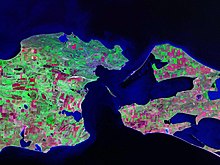User:S.R. Summerfield/KubanBridgehead
| The Kuban Bridgehead | |||||||
|---|---|---|---|---|---|---|---|
| Part of the Battle of the Caucasus in the Second World War | |||||||
 German Forces Evacuating Kuban Bridgehead | |||||||
| |||||||
| Belligerents | |||||||
|
|
| ||||||
The Kuban Bridgehead (German: Kuban-Brückenkopf), also know as the "Goth's head position" (German: Gotenkopfstellung)[3], was a German position on the Taman Peninsula, located in what is today the Southern Federal District of Russia. Existing from January to October 1943 the Bridgehead formed after the German withdrawal from the Caucasus, and provided a defensible consolidation position for the Wehrmacht. The position was intended as a staging area which was to be used to renew attacks towards the oil wells of the Caucasus. The Bridgehead was abandoned when the Panther-Wotan line was breached, resulting in German forces being evacuated across the Kerch Strait to Crimea.
Prelude
[edit]Case Blue (Fall Blau), launched 28 June 1942, saw Army Group South (Heersgruppe Süd) divided into two Army Groups, Army Group A ( Heersgruppe A) and Army Group B (Heersgruppe B), the former participating in the Battle of the Caucasus. Throughout the Operation the German situation, especially that of Army Group B centered on Stalingrad, began to deteriorate.[1] As Army Group B began collapsing in the North, Army Group A quickly found itself at risk of being flanked. The Army Group was forced to abandon its task of securing the oilfields of the Caspian, and began withdrawing down the Terek River toward the Taman Peninsula.[1]
Bridgehead
[edit]
With the cancellation of Case Blue by Hitler in December 1942, having become unsustainable due to long supply lines and the encirclement of the 6th Army at Stalingrad, Army Group A withdrew towards the Black Sea and Crimea.[4] The 17th Army, commanded by Generaloberst Richard Ruoff, and Erwin Jaenecke, future General der Pioniere, constructed a defensive position along the Kuban River in the Taman Peninsula, which was completed in January 1943. German forces, moving from positions along the Terek River, fully occupied the new defensive network in February 1943 while under constant attack by the Red Army .[4] The defensive network successfully held the Soviet North Caucasian Front until 9 October 1943, when the last German unit crossed the Kerch Strait to Crimea. The Bridgehead, originally intended to provide a staging area for future attempts to gain control of the Caspian oil fields, was re-tasked on 3 September 1943[5], as the German situation on the Eastern Front continued to deteriorate.[4] The Kuban Bridgehead would then serve to evacuate German forces as the withdrawal of Army Group South to the Dneiper Line had become inevitable.[4]
Despite repeated Soviet attacks the Kuban Bridgehead held resulting in the evacuation of: 239,699 soldiers, 16,311 wounded, 27,456 civilians, 115,477 tonnes of supplies (including ammunition), 21,230 motor vehicles, 74 tanks, 1,815 guns, and 74,657 horses to the Crimea. The Luftwaffe, operating from a field airport at Slavyanskaya, withdrew a further 15,661 men. The withdrawal from the Taman Peninsula represents one of the few operations where an Army and the entirety of its heavy equipment were not lost. Transportation over the narrowest point of the strait, measuring four kilometers, was done by Marinefährprahm and a sea cableway. A combined road and rail bridge was constructed by the Todt Organization but was destroyed shortly before completion in October 1943.
Major German Operations
[edit]- Battle of Krasnodar (1–11 February 1943)
- German defensive battles to prevent the Red Army outflanking the left wing of the army (1 February to 4 March 1943 and 26 to 31 March 1943)
- German defensive actions against Soviet landings at Novorossiysk (3 to 28 February 1943)
- Battle of Abin (12 to 1 February 1943)
- German defence of the Troizkoje bridgehead (2 to 8 March 1943)
- Battle for Abinskaja (10 to 16 March 1943)
- German defensive battle at Krymskaja with defense of Kurka front (4 to 18 April 1943)
- German attack against Novorossiysk beachhead (17 to 20 April 1943)
- German defensive battle at Krymskaja with simultaneous defense of the enemy attack in Novorossiysk (29 April to 10 May 1943)
- German defensive battle at Krymskaja (26 May to 8 June 1943)
- German defensive battle at Krymskaja with offensive and defensive battles in Neberdschajewskaja and defense of attacks on Kurka section (16 July to 13 August 1943)
- German defence of the Soviet landing attack at Novorossiysk (10 May to 9 October 1943)[6]
Kuban Shield
[edit]Members of the Wehrmacht who fought to preserve the bridgehead on the Taman Peninsula were awarded the Kuban Shield, provided they met the criteria.
In popular culture
[edit]- The Kuban Bridgehead was the setting for the 1977 film Cross of Iron.
See also
[edit]References
[edit]- ^ a b c d Encyclopedia of World War II: A Political, Social, and Military History. Oxford, England: ABC-CLIO. 2005. p. 307. ISBN 1-57607-999-6.
- ^ a b Tessin, G., Verbänd und Truppen der detuschen Wermacht und Waffen - SS im Zweiten Weltkrieg 1939-1945, Biblo Verlag, Osnabruck, 1977. taken from http://www.cgsc.edu/CARL/nafziger/939GXXP.PDF pg 10
- ^ Weinberg, Gerhard L. (2005). A World at Arms: A Global History of World War II Second Edition. New York, NY: Cambridge University Press. p. 456. ISBN 978-0-521-61826-7.
- ^ a b c d Encyclopedia of World War II: A Political, Social, and Military History. Oxford, England: ABC-CLIO. 2005. p. 307. ISBN 1-57607-999-6.
- ^ Weinberg, Gerhard L. (2005). A World at Arms: A Global History of World War II Second Edition. New York, NY: Cambridge University Press. p. 605. ISBN 978-0-521-61826-7.
- ^ "Auszeichnungen des Deutschen Reiches 1936-1945" von Kurt-G. Klietmann. p. 91-92.
General references
[edit]- Friedrich Forstmeier: Die Räumung des Kuban-Brückenkopfes im Herbst 1943. Wehr und Wissen Verlags-Gesellschaft, Darmstadt 1964 (Beiträge zur Wehrforschung 2/3, ISSN 0067-5253)
- Wolfgang Pickert: Vom Kuban-Brückenkopf bis Sewastopol. Flakartillerie im Verband der 17. Armee. Vowinckel, Heidelberg 1955 (Die Wehrmacht im Kampf 7, ZDB-ID 521615-1)
Category:Eastern Front (World War II) Category:Kuban Category:1943 in the Soviet Union
